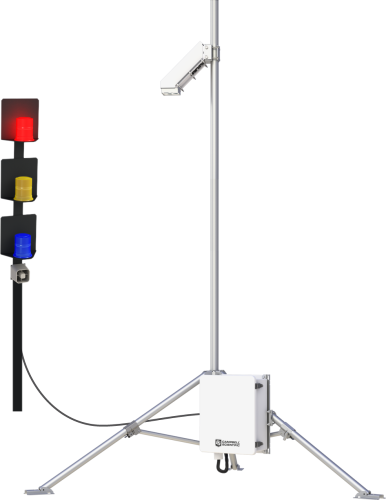This product is no longer available.

| 利用できるサービス |
|---|
概要
The LW110 provides continuous monitoring of the local electric field and triggers warnings when there is the potential for lightning. Because warnings are based on measurements of electric field, instead of prior strikes, the system can detect lightning danger, even when no other strikes have occurred.
By measuring the electric field at your location, the LW110 can be relied upon to remove the guesswork from critical decisions: when to seek shelter as a storm approaches, and when it’s safe to resume activities as a storm passes.
The LW110 is customizable, allowing you to add a lightning strike detector, meteorological sensors, and various communication, power, and mounting options.
利点と特徴
- First strike warning--senses potential for lightning
- "All clear" notices when lightning threat has passed
- Up to 7 mile detection radius
- Visual and audible alarms
- PC, web, and email alarms when communication is added
- Optional SG000 detects strikes up to 20 mile radius and can be added to create a complete lightning-threat measurement and analysis system
- Optional meteorological sensors for expanded weather monitoring and logging
- Rugged construction
- Low power consumption
- Low maintenance—extensive diagnostics let you know when maintenance is needed
イメージ

互換性
|
IMPORTANT! The CS110 should not be run with OS 28 (CR1000.Std.28.obj). A bug in OS 28 prevents changing the setup "Constants" via the keyboard or the terminal emulator. |
ドキュメント
よくある質問
LW110に関するよくある質問の数: 6
すべて展開すべて折りたたむ
-
CS110 とタワーは、タワーの高さの 3 倍の距離を離して設置する必要があります。
無線信号が十分に強い場合、SG000 は雷を検出するために SG000 が測定する 2 つの要素の 1 つとして無線信号を誤って検出する可能性があります。この信号がフロントガラスまたはヘッドライトの閃光と一致すると、誤った落雷信号が生成される可能性があります。また、十分に強い RF 信号が SG000 に継続的に照射されると、センサが静止状態にならず、電流の消費に影響します。これにより、最終的にバッテリが劣化し、予想される 4 年の寿命が短くなります。
-
SG000 への落雷をシミュレートするには、カメラのフラッシュを使用して、ガラスの電球を 5.08 ~ 7.62 cm (2 ~ 3 インチ) の距離からフラッシュします。注: 携帯電話のフラッシュは通常、落雷をシミュレートするには十分な明るさではありません。
CS110 で高電界をシミュレートするには、髪に櫛を通し、CS110 のシャッターから 2.54 ~ 5.98 cm (1 ~ 2 インチ) の距離に置きます。ビニール袋や風船、ガラスに付けた毛皮などの他のアイテムも使用できます。
-
FC100 は、SG000 Strike Guard 雷センサと通信するために必要です。SG000 は、CS110 電界センサおよび LW110 雷警告システムのオプションです。
-
すべてのセンサに異なるケーブル終端オプションがあるわけではありません。特定のセンサで利用可能なオプションは、センサ製品ページの注文情報エリアの 2 つの場所で確認できます。
モデル番号
ケーブル終端オプション リスト
センサが –ET、–ETM、–LC、–LQ、または –QD バージョンで提供されている場合、そのオプションが利用可能かどうかはセンサモデル番号に反映されます。たとえば、034B は 034B-ET、034B-ETM、034B-LC、034B-LQ、および 034B-QD として提供されています。その他のすべてのケーブル終端オプション (利用可能な場合) は、センサ製品ページの注文情報エリアの「ケーブル終端オプション」の下にリストされています。たとえば、034B-L 風力発電セットは、034B-L 製品ページの注文情報エリアに示されているように、–CWS、–PT、および –PW オプションで提供されています。
注意: 新しい製品が在庫に追加されると、通常は複数のモデル番号を作成するのではなく、1 つのセンサモデルの下に複数のケーブル終端オプションをリストします。たとえば、HC2S3-L には、HC2S3-LC モデルではなく、CS110 に接続するための –C ケーブル終端オプションがあります。
-
Campbell Scientific のセンサのほとんどは、ユーザー指定のケーブル長を示す –L として提供されています。センサが –LX モデル (「X」は他の文字) としてリストされている場合、そのセンサのケーブルの長さはユーザー指定ですが、固有のシステム用の特定のコネクタで終端されます。
- -LC モデルには、ET107、CS110、または廃止された Metdata1 に接続するためのユーザー指定のケーブル長があります。
- -LQ モデルには、RAWS-P 気象ステーションに接続するためのユーザー指定のケーブル長さがあります。
センサのメイン モデル番号の後に –L または –LX の指定がない場合、センサのケーブル長は設定されています。ケーブル長は、製品の注文情報の説明フィールドの末尾に記載されています。たとえば、034B-ET モデルの説明は、「ET ステーション用 Met One Wind セット、67 インチ ケーブル」です。ケーブル長が設定されている製品は、デフォルトでバラ線で終端されます。
ケーブルが特定のシステム用の特別なコネクタで終端されている場合、モデル番号の末尾でそのシステムを指定します。たとえば、034B-ET モデルは、ET107 システムのセンサを 034B として指定します。
- –ET モデルは、ET107 気象ステーション用のコネクタです。
- –ETM モデルは ET107 気象ステーション用のコネクタですが、交換部品を購入するときに便利な特別なシステム マウントも含まれています。
- –QD モデルは、RAWS-F クイック展開ステーション用のコネクタです。
- –PW モデルは、PWENC または配線済みシステム用のコネクタです。
-
多くの Campbell Scientific センサは、さまざまなケーブル終端オプションで利用できます。これらのオプションには次のものがあります。
- –PT (–PT w/Tinned Wires) オプションはデフォルトのオプションであり、他のオプションのように製品ラインには表示されません。ケーブルは、データロガーに直接接続するバラ線で終端します。
- –C (–C w/ET/CS110 コネクタ) オプションでは、ケーブルは CS110 電界メータまたは ET シリーズ気象ステーションに接続するコネクタで終端します。
- –CWS (–CWS w/CWS900 コネクタ) オプションでは、ケーブルは CWS900 シリーズ インターフェイスに接続するコネクタで終端します。CWS900 シリーズ インターフェイスに接続すると、センサをワイヤレス センサー ネットワークで使用できるようになります。
- –PW (–PW w/Pre-Wire Connector) オプションでは、ケーブルは事前に配線されたエンクロージャに接続されるコネクタで終端します。
- –RQ (–RQ w/RAWS コネクタ) オプションでは、ケーブルは RAWS-P 常設リモート自動気象ステーションに接続するコネクタで終端します。
注意: ケーブル終端オプションの選択肢はセンサによって異なります。たとえば、センサには選択可能なオプションがまったくないか、複数ある場合があります。特定のセンサに必要なオプションがリストされていない場合は、Campbell Scientific に問い合わせてサポートを受けてください。
ケーススタディ
The Professional Golfers’ Association Tour (PGA Tour) of America contracted with Schneider Electric to provide......続きを読む
Lightning strikes are a serious concern for school officials who are responsible for protecting the......続きを読む
Lightning kills about 40 people a year in the highland areas of Peru. This startling......続きを読む
Privacy Policy Update
We've updated our privacy policy. 詳細はこちら
Cookie Consent
Update your cookie preferences. クッキーの設定を更新する



